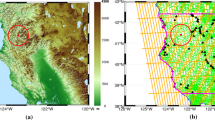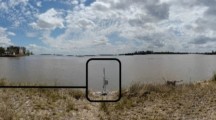Abstract
In this paper the problem of retrieving wind field information from Doppler radar data motivates the formulation of a method to design radar network configurations. The problem of estimating wind velocities from radar data is posed and used to construct a certain retrieval operator. This operator contains a factor that may be interpreted as an uncertainty multiplier. It depends on the geometry of the configuration of the radar network. The uncertainty multiplier is shown to vary continuously with perturbations of the network configuration. It is also shown to be a generalization of the Doppler angle condition used in meteorology. Numerical examples are presented to determine a network of five radars minimizing the uncertainty multiplier for the problem. Also, a configuration of sites is determined that maximizes the area of the Doppler region.
Similar content being viewed by others
References
Biggerstaff, M.: Geometric uncertainty factor. Personal communication
Brewster, K., White, L., Brotzge, J., Johnson, W.: Site considerations and optimization of the NetRad radar network. In: Proceedings of the American Meteorological Society (2005)
Ciarlet, P.: The Finite Element Method for Elliptic Problems. North-Holland, Amsterdam (1980)
Gilbarg, D., Trudinger, N.: Elliptic Partial Differential Equations, 2nd edn. Springer, New York (1983)
Lions, J.L.: Distributed Optimal Control of Systems Governed by Partial Differential Equations. Springer, New York (1969)
Luenberger, D.G.: Optimization by Vector Space Methods. Wiley, New York (1969)
Maz’ja, V.G.: Sobolev Spaces. Springer, New York (1985)
Mewes, J., Shapiro, A.: Use of the vorticity equation in dual-Doppler analysis of the vertical velocity field. J. Atmos. Ocean. Technol. 19, 543–567 (2002)
Royden, H.L.: Real Analysis, 3nd edn. Macmillan Co., New York (1988)
Schultz, M.: Spline Analysis. Prentice-Hall, Englewood Cliffs (1973)
Shapiro, A., Mewes, J.: New formulations of dual-Doppler wind analysis. J. Atmos. Ocean. Technol. 16, 782–792 (1999)
Shapiro, A., Robinson, P., Wurman, J., Gao, J.: Single-Doppler velocity retrieval with rapid scan radar data. J. Atmos. Ocean. Technol. 20, 1758–1174 (2000)
Stewart, G.W.: Introduction to Matrix Computations. Academic Press, New York (1973)
White, L., Shapiro, A.: Optimization of wind field retrieval procedures. Appl. Math. Comput. 171, 25–52 (2005)
Author information
Authors and Affiliations
Corresponding author
Rights and permissions
About this article
Cite this article
White, L., Shapiro, A. & White, F. Radar placement based on a geometric uncertainty multiplier reduction criterion. Comput Optim Appl 41, 61–80 (2008). https://doi.org/10.1007/s10589-007-9100-6
Received:
Revised:
Published:
Issue Date:
DOI: https://doi.org/10.1007/s10589-007-9100-6




